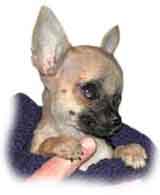Small Dog BreedsInformation About The Wire Fox Terrier Dog Breed |
|
|
The Wire Fox Terrier has a strong, athletic body and a short, wiry coat with a soft undercoat. Although he is very much the same as the Smooth Fox Terrier in behavior, the Wire Fox Terrier does show some interesting differences. Similar to the Smooth, he is feisty, lively, and very independent, but tends to be a slightly slower learner than the Smooth, perhaps because of his more distractible nature. He is intelligent, cheerful, and gets along well with children. He is a great ratter and makes a wonderful pet. He has a very high prey drive and is more dog-aggressive than the Smooth. This dog is perhaps the most combative terrier aside from the Bedlington. He is wary of strangers, makes a good watchdog, and tends to defend himself if provoked. He likes to bark and dig, sometimes incessantly and should not be left in the yard for a long period of time. Training should begin early and be consistent. Though he is an intelligent dog, some commands such as the "down" and "come" may be difficult to teach to this willful and stubborn breed. Size: A healthy, full-sized adult wire Fox Terrier should not exceed 15 ½ in at the shoulder, with the female slightly smaller than the male. He weighs between 10-20lb. History and origin: He is a separate breed from the Smooth coat, although they are the same in conformation. He was used in the 18 th century in England as a bolter of foxes and as a ratter. This breed was derived from the wire-haired terriers around the British coalmining areas of Durham, Wales, and Derbyshire, where he had existed for some time before gaining popularity. His first appearance in the show ring was in 1872. This breed was responsible for the development of the Kromfohrlander, a guarding and hunting breed in Germany. Feeding: Recommended feeding for this breed is ½ - 1 can of high quality meat product (13.3oz size) with added biscuit in similar amount or 1 ½ cupfuls of a complete dry food. Exercise: Wire Fox Terriers like to retrieve. This is a great method to use in order to focus the dog's attention and also as a constructive exercise. Apartment living is adequate for this breed if he is given daily exercise. A spacious fenced yard is perfect for this active terrier as long as you do not leave him there for too long because he has a tendency to bark incessantly and dig his way out. He needs proper exercise everyday such as jogging, brisk walk or retrieving. Without activity, he may become noisy, restless, and destructive. Grooming: He has a short and wiry coat with minimal shedding. Periodic brushing and clipping are required. Hand-stripping, a plucking method that preserves the texture and luster of the coat is required for show dogs.Back to the Small Dog Breed page
| |
|
Related News About Dogs ' ); // get rid of newsfeed display by carp CarpConf('poweredby',''); CarpCacheShow('http://www.small-dog-info.com/support-files/rss.xml'); ?>
|
|
|
|
|
|
Copyright © 2006-2007 dogguidance.com |


